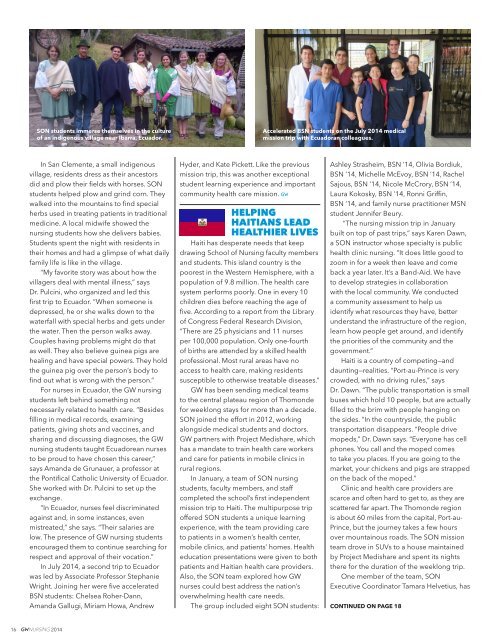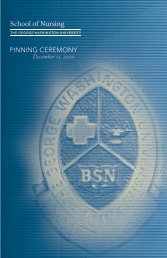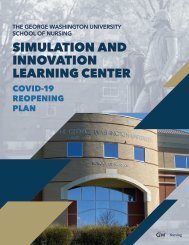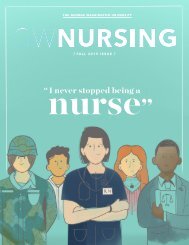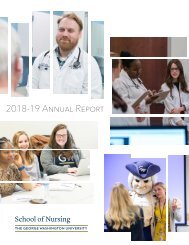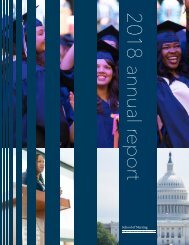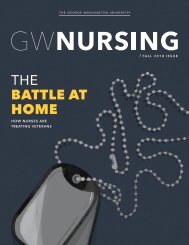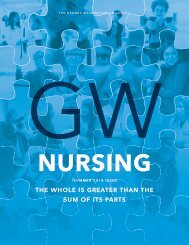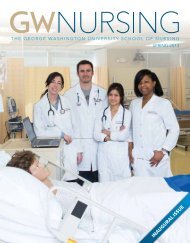GW Nursing Magazine 2014
GW Nursing is a publication of the George Washington University School of Nursing. The magazine tells the story of GW nurses and their endeavors in the areas of education, research, policy and practice.
GW Nursing is a publication of the George Washington University School of Nursing. The magazine tells the story of GW nurses and their endeavors in the areas of education, research, policy and practice.
You also want an ePaper? Increase the reach of your titles
YUMPU automatically turns print PDFs into web optimized ePapers that Google loves.
SON students immerse themselves in the culture<br />
of an indigenous village near Ibarra, Ecuador.<br />
Accelerated BSN students on the July <strong>2014</strong> medical<br />
mission trip with Ecuadoran colleagues.<br />
In San Clemente, a small indigenous<br />
village, residents dress as their ancestors<br />
did and plow their fields with horses. SON<br />
students helped plow and grind corn. They<br />
walked into the mountains to find special<br />
herbs used in treating patients in traditional<br />
medicine. A local midwife showed the<br />
nursing students how she delivers babies.<br />
Students spent the night with residents in<br />
their homes and had a glimpse of what daily<br />
family life is like in the village.<br />
“My favorite story was about how the<br />
villagers deal with mental illness,” says<br />
Dr. Pulcini, who organized and led this<br />
first trip to Ecuador. “When someone is<br />
depressed, he or she walks down to the<br />
waterfall with special herbs and gets under<br />
the water. Then the person walks away.<br />
Couples having problems might do that<br />
as well. They also believe guinea pigs are<br />
healing and have special powers. They hold<br />
the guinea pig over the person’s body to<br />
find out what is wrong with the person.”<br />
For nurses in Ecuador, the <strong>GW</strong> nursing<br />
students left behind something not<br />
necessarily related to health care. “Besides<br />
filling in medical records, examining<br />
patients, giving shots and vaccines, and<br />
sharing and discussing diagnoses, the <strong>GW</strong><br />
nursing students taught Ecuadorean nurses<br />
to be proud to have chosen this career,”<br />
says Amanda de Grunauer, a professor at<br />
the Pontifical Catholic University of Ecuador.<br />
She worked with Dr. Pulcini to set up the<br />
exchange.<br />
“In Ecuador, nurses feel discriminated<br />
against and, in some instances, even<br />
mistreated,” she says. “Their salaries are<br />
low. The presence of <strong>GW</strong> nursing students<br />
encouraged them to continue searching for<br />
respect and approval of their vocation.”<br />
In July <strong>2014</strong>, a second trip to Ecuador<br />
was led by Associate Professor Stephanie<br />
Wright. Joining her were five accelerated<br />
BSN students: Chelsea Roher-Dann,<br />
Amanda Gallugi, Miriam Howa, Andrew<br />
Hyder, and Kate Pickett. Like the previous<br />
mission trip, this was another exceptional<br />
student learning experience and important<br />
community health care mission.<br />
HELPING<br />
HAITIANS LEAD<br />
HEALTHIER LIVES<br />
Haiti has desperate needs that keep<br />
drawing School of <strong>Nursing</strong> faculty members<br />
and students. This island country is the<br />
poorest in the Western Hemisphere, with a<br />
population of 9.8 million. The health care<br />
system performs poorly. One in every 10<br />
children dies before reaching the age of<br />
five. According to a report from the Library<br />
of Congress Federal Research Division,<br />
“There are 25 physicians and 11 nurses<br />
per 100,000 population. Only one-fourth<br />
of births are attended by a skilled health<br />
professional. Most rural areas have no<br />
access to health care, making residents<br />
susceptible to otherwise treatable diseases.”<br />
<strong>GW</strong> has been sending medical teams<br />
to the central plateau region of Thomonde<br />
for weeklong stays for more than a decade.<br />
SON joined the effort in 2012, working<br />
alongside medical students and doctors.<br />
<strong>GW</strong> partners with Project Medishare, which<br />
has a mandate to train health care workers<br />
and care for patients in mobile clinics in<br />
rural regions.<br />
In January, a team of SON nursing<br />
students, faculty members, and staff<br />
completed the school’s first independent<br />
mission trip to Haiti. The multipurpose trip<br />
offered SON students a unique learning<br />
experience, with the team providing care<br />
to patients in a women’s health center,<br />
mobile clinics, and patients’ homes. Health<br />
education presentations were given to both<br />
patients and Haitian health care providers.<br />
Also, the SON team explored how <strong>GW</strong><br />
nurses could best address the nation’s<br />
overwhelming health care needs.<br />
The group included eight SON students:<br />
Ashley Strasheim, BSN ’14, Olivia Bordiuk,<br />
BSN ’14, Michelle McEvoy, BSN ’14, Rachel<br />
Sajous, BSN ’14, Nicole McCrory, BSN ’14,<br />
Laura Kokosky, BSN ’14, Ronni Griffin,<br />
BSN ’14, and family nurse practitioner MSN<br />
student Jennifer Beury.<br />
“The nursing mission trip in January<br />
built on top of past trips,” says Karen Dawn,<br />
a SON instructor whose specialty is public<br />
health clinic nursing. “It does little good to<br />
zoom in for a week then leave and come<br />
back a year later. It’s a Band-Aid. We have<br />
to develop strategies in collaboration<br />
with the local community. We conducted<br />
a community assessment to help us<br />
identify what resources they have, better<br />
understand the infrastructure of the region,<br />
learn how people get around, and identify<br />
the priorities of the community and the<br />
government.”<br />
Haiti is a country of competing—and<br />
daunting—realities. “Port-au-Prince is very<br />
crowded, with no driving rules,” says<br />
Dr. Dawn. “The public transportation is small<br />
buses which hold 10 people, but are actually<br />
filled to the brim with people hanging on<br />
the sides. ”In the countryside, the public<br />
transportation disappears. “People drive<br />
mopeds,” Dr. Dawn says. “Everyone has cell<br />
phones. You call and the moped comes<br />
to take you places. If you are going to the<br />
market, your chickens and pigs are strapped<br />
on the back of the moped.”<br />
Clinic and health care providers are<br />
scarce and often hard to get to, as they are<br />
scattered far apart. The Thomonde region<br />
is about 60 miles from the capital, Port-au-<br />
Prince, but the journey takes a few hours<br />
over mountainous roads. The SON mission<br />
team drove in SUVs to a house maintained<br />
by Project Medishare and spent its nights<br />
there for the duration of the weeklong trip.<br />
One member of the team, SON<br />
Executive Coordinator Tamara Helvetius, has<br />
CONTINUED ON PAGE 18<br />
16 <strong>2014</strong>


